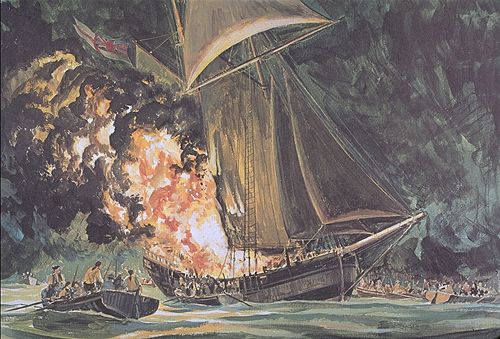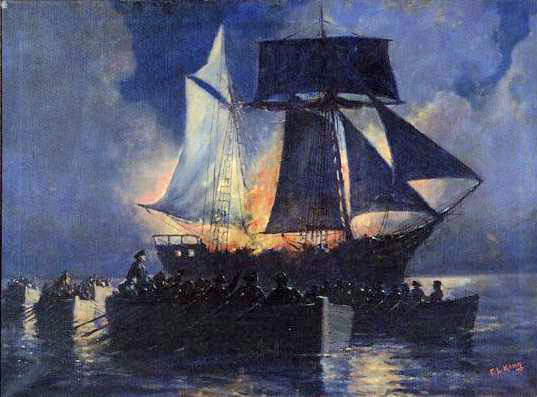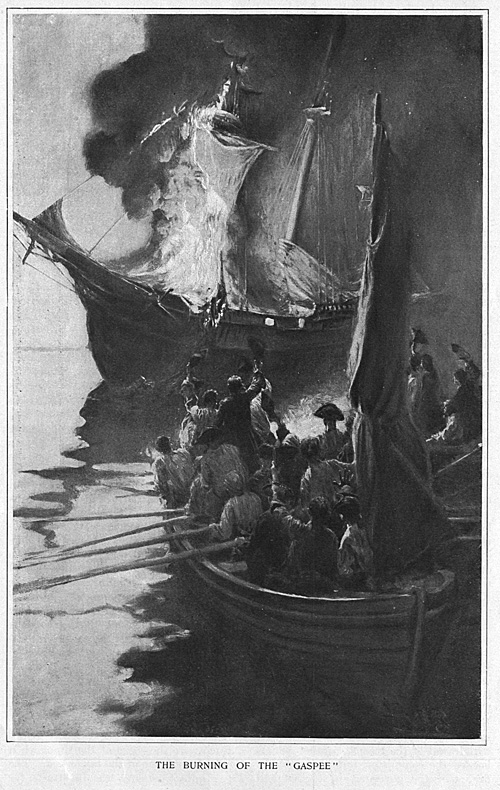|


_____________
In this section of
Gaspee History


____________
Go the section on
Gaspee Raiders
for biographical
information on the Americans in the boats attacking the Royal Navy ship
Gaspee.
_____________
Books: American Colonial and
Revolutionary War history or the people involved. We have suggestions
for you.

_____________
Copyrighted.
© 2005
to Oct.2009, Leonard H. Bucklin.
-----
The
content of this site may not be reproduced except for brief excerpts for
reviews or scholarly references..
See
Copyright Notices,
Privacy Policy, and Warnings & Disclaimers.
_____________

This is a history education and
research web site of the
Joseph Bucklin Society.
 References
in brackets [ ] or in curly brackets { } on any page in
this website are to books, or other materials, listed in the Joseph
Bucklin Society Gaspee Bibliography, or to materials held by the Joseph
Bucklin Society. References
in brackets [ ] or in curly brackets { } on any page in
this website are to books, or other materials, listed in the Joseph
Bucklin Society Gaspee Bibliography, or to materials held by the Joseph
Bucklin Society.
|

|
The "longboats" of the Gaspee
attackers were
probably about 10 feet wide and 30 feet long,
easily holding 15 or more men in each of the eight longboats.
 For
the transport of the attacking force, John Brown asked for the largest longboats
available from the substantial fleet of ships in the Providence harbor.
Such longboats used in merchant ships frequently were over 10 feet wide. To give
you the flavor of the type of boats in use at that time, take a look at illustrations by artists in 1700's
and 1800's, when sailing ships were still in use. These are helpful to show you the design and size of the longboats
likely to have been involved in the
American attack on the Gaspee. For example, on the left is a contemporary
engraving intended to show the last boatload of English Marines leaving
Boston Harbor after the defeat of the English at the start of the Revolutionary
War. It is a English Navy "barge" used by fleet officers and to transport the
ship's marines into battle. It is to be remembered that Lt. Dudingston, after
the destruction of the Gaspee, reported he was transported in a "barge" from the
Gaspee to the shore. For
the transport of the attacking force, John Brown asked for the largest longboats
available from the substantial fleet of ships in the Providence harbor.
Such longboats used in merchant ships frequently were over 10 feet wide. To give
you the flavor of the type of boats in use at that time, take a look at illustrations by artists in 1700's
and 1800's, when sailing ships were still in use. These are helpful to show you the design and size of the longboats
likely to have been involved in the
American attack on the Gaspee. For example, on the left is a contemporary
engraving intended to show the last boatload of English Marines leaving
Boston Harbor after the defeat of the English at the start of the Revolutionary
War. It is a English Navy "barge" used by fleet officers and to transport the
ship's marines into battle. It is to be remembered that Lt. Dudingston, after
the destruction of the Gaspee, reported he was transported in a "barge" from the
Gaspee to the shore.
 Likewise,
on the right, is another help to visualize the ship's longboat used in the
merchant fleets of the time, when boats were frequently need to transport both
people and merchandise to and from the ship. (The painting on the right is
a contemporary painting of the use of ship's boats in getting persons and goods
ashore in the Caribbean.) Likewise,
on the right, is another help to visualize the ship's longboat used in the
merchant fleets of the time, when boats were frequently need to transport both
people and merchandise to and from the ship. (The painting on the right is
a contemporary painting of the use of ship's boats in getting persons and goods
ashore in the Caribbean.)
Illustrations of the attack done in the period of approximately 100 years
near the 1772 Gaspee attack frequently showed the attacking longboats as having five pairs of oars
and as easily accommodating more than 15 persons in each longboat. For examples note
the longboats shown in the three below art works. The first below painting at
one time hung in the U.S.
Naval War College (where they acknowledge the Gaspee attack and the shot
fired by Joseph Bucklin as part of U.S. Navy military history), and, we assume,
would not have been chosen for the War College if the maritime details were not
in accordance with facts of the century involved. The second below painting by marine illustrator
Frederick Leonard King, and the third below engraving used
in Harpers Monthly Magazine, were both intended to accurately show the
event. All show longboats of considerable size, with five pairs of oars.



The last above image, an engraving, was printed in
Harpers Monthly Magazine, at page 471, August, 1901, to illustrate
an article on the American Revolution. Among other things, the illustration
accurately indicates the Gaspee as a grounded
ship, not as one floating in the water. As to the longboat, the illustration
accurately shows that longboats usually had some provision for erecting
a mast and sails. That capability was needed because they were built to be capable
of being lifeboats in case of disaster at sea, and for sailing substantial distances
in on or off-loading of
cargo. A longboat might have more than one mast if the ship captain wanted to be able to sail the longboat a substantial distance.
See, e.g., the sail configuration on the modern reconstructed long boat shown in
the photo on the right. However, we can assume that the attackers, who intended
on rowing, did not have a mast and sail raised during the attack. because they were built to be capable
of being lifeboats in case of disaster at sea, and for sailing substantial distances
in on or off-loading of
cargo. A longboat might have more than one mast if the ship captain wanted to be able to sail the longboat a substantial distance.
See, e.g., the sail configuration on the modern reconstructed long boat shown in
the photo on the right. However, we can assume that the attackers, who intended
on rowing, did not have a mast and sail raised during the attack.
Now, let's leave aside illustrations as helping us, and use historical facts
and reasoning.
Historical facts and several lines of reasoning lead to an estimate that the Gaspee raiders used
longboats each about 30 feet
long --- and easily capable of holding at least 15 men in each longboat.
The standard size of longboats of the 1700's.
By 1750 shipbuilding in Massachusetts and Rhode Island had
reached high levels of manufacturing sophistication in regard to both ship
design and ship building. More ships were being built in New England than in
England, and ships were built not only because of a request by a prospective
purchaser, but also simply to have one available for sale. There were
common formulas used to determine various aspects of the ship once the length of
the ship was agreed upon. These formulas included the length and size of the
ship's longboat, as well as the number of ("pairs" of) oars.
As to length of the ship's longboat, the formula was the
square root of the length of the ship, multiplied by two. This produced a
longboat that could be carried on the deck of its ship, but maximized as to how
worthy the longboat would be for an emergency lifeboat or for carrying cargo to
and from shore.
These 18th century formulas mean to us that the "largest
long-boats in the harbor" (John Brown's requisition order) in Providence would
have been more than 25 feet long, probably 30 feet or more long. For
example, John Brown's sloop Katy, not an exceptionally large ship, if in the
harbor would, under standing shipbuilding formulas, have had a longboat that was
27 feet in length, 10 feet wide, with 7 pairs of oars.
See more on the sample
specifications of longboats of that day.
Bowen's description of the longboats.
We all start with the description given by Bowen:
"Mr. Brown immediately resolved on her destruction, and he forthwith
directed one of his trusty shipmasters to collect eight of the largest
long-boats in the harbor, with five oars to each..."
"Five oars", spoken by a seaman in the 18th and 19th centuries, usually meant 5 pairs
of oars.
Bowen's 18th century description is a strange description to 21st century city
dwellers, used to rowboats of today. "Five oars" is an odd number, not an even number of
oars, and we assume that rowing takes an even number of oars. At first we
think that Bowen wants to tell us that the fifth oar was used for steering
(which does not make much sense because long-boats would commonly be steered by
a tiller) Then we think that Bowen wants to tell us the fifth oar was to be a
spare. (That also does not make much sense, because the persons whom he was
addressing really would not care whether a spare oar was carried). And since we
do not know by experience what an ordinary long boat of the day was, and cannot
picture in our mind the size involved --- "largest" doesn't seem to
help us much without some further digging. Most of us today stop after reading
Bowen's description, and we do not spend time thinking about what it means.
If the audience is composed of 18th century persons familiar with ship's
boats use --- "five oars" does say something about the size of the
boats. And, on close examination, Bowen's "largest" description
does tell us something about the size of the boats.
In the 18th Century, the nautical term of "oars" when
describing a boat, could mean either "single oars" or
"pairs of oars". For an example of the use "oars"
to mean "pair of oars" , see the Table of Boats carried by British
vessels of war by William Mountaine, The Seaman's Vade-Mecum (London,
1757). British warships carried a variety of small boats, for different
purposes. Mountaine describes the oars of the various "Long
Boats" as e.g., "7 oars" or 8 oars" Yet, if you look
at the same type of long-boats in the British Navy drawings, you will see
the oars set out as "7 Pair" or "8 Pair". E.g.,
"18th Century Longboats After Chapman", at Notes on 18th Century
Ship's Boats, Vol. 26, Nautical Research Journal, p 209 et seq.
(Nautical Research Guild, Washington, D.C., Dec., 1980). So if you were in the
merchant service, or in the navy, "a longboat with five
oars, meant the largest boat a ship could carry (see continuation page,
below) with five sets of oars.
So, to sum up, if you were in the navy or on most merchant ships, you used a
"longboat" which if it was said to have "five oars", it meant five sets of
oars. The size of the longboat varied according to the size of the ship it
was on; the larger the ship, the larger the ship's longboat.
The only sort of boat that might be described as having the odd number of
five oars was a "whaleboat" which had six oars but only five of which were used
primarily for rowing. The whaling industry in 1772 was sufficiently developed so
that whaleboats had a common size and design: a whaleboat would almost always be
only 28 feet long and only six feet wide, no matter how big the ship used for
the whaling enterprise.
In contrast, the longboats of merchant
ships varied in size according to the size of the ship, and were designed to
carry many men or substantial cargo. Merchant ships of the day usually
carried one long boat (a "longboat" designed to carry merchandise to and
from the ship, and to be a substantial lifeboat if the ship sank. The
standard formula for the "longboat" (largest boat carried on the ship) was
figured by taking the square root of the length of the ship and multiplying that
square root number by 2.6. A sloop's long boat would not be unusual at 28 or so
feet in length.
Bowen referred to all the boats as "longboats" and not as
"whaleboats" which strongly suggest that he meant boats with five sets of oars,
not whaleboats with their unusual configuration and limited space for men to be
transported. Mawney referred to his
boat as a "barge". A barge was included in the general term of
"longboat" as meaning the largest boat carried by the merchant ships
and navy ships. A ship's barge was the type of big boat found only on ships of
the line and other large navy ships. It not only was used for carrying the
ranking officer, but also for the landing of marines and troops. A barge would
ordinarily note be handled by five single oars, but rather by five sets of oars. The "barge" term
tends to lead to the conclusion that the boats probably had five "sets"
of oars.
Discussion continued about the size
of the longboats in the Gaspee attack.

For your further information on ships of the
1600 to 1799 era,
use the links in the left margin of this page.
The Table of Contents to this Site.
|



 For
the transport of the attacking force, John Brown asked for the largest longboats
available from the substantial fleet of ships in the Providence harbor.
Such longboats used in merchant ships frequently were over 10 feet wide. To give
you the flavor of the type of boats in use at that time, take a look at illustrations by artists in 1700's
and 1800's, when sailing ships were still in use. These are helpful to show you the design and size of the longboats
likely to have been involved in the
American attack on the Gaspee. For example, on the left is a contemporary
engraving intended to show the last boatload of English Marines leaving
Boston Harbor after the defeat of the English at the start of the Revolutionary
War. It is a English Navy "barge" used by fleet officers and to transport the
ship's marines into battle. It is to be remembered that Lt. Dudingston, after
the destruction of the Gaspee, reported he was transported in a "barge" from the
Gaspee to the shore.
For
the transport of the attacking force, John Brown asked for the largest longboats
available from the substantial fleet of ships in the Providence harbor.
Such longboats used in merchant ships frequently were over 10 feet wide. To give
you the flavor of the type of boats in use at that time, take a look at illustrations by artists in 1700's
and 1800's, when sailing ships were still in use. These are helpful to show you the design and size of the longboats
likely to have been involved in the
American attack on the Gaspee. For example, on the left is a contemporary
engraving intended to show the last boatload of English Marines leaving
Boston Harbor after the defeat of the English at the start of the Revolutionary
War. It is a English Navy "barge" used by fleet officers and to transport the
ship's marines into battle. It is to be remembered that Lt. Dudingston, after
the destruction of the Gaspee, reported he was transported in a "barge" from the
Gaspee to the shore. Likewise,
on the right, is another help to visualize the ship's longboat used in the
merchant fleets of the time, when boats were frequently need to transport both
people and merchandise to and from the ship. (The painting on the right is
a contemporary painting of the use of ship's boats in getting persons and goods
ashore in the Caribbean.)
Likewise,
on the right, is another help to visualize the ship's longboat used in the
merchant fleets of the time, when boats were frequently need to transport both
people and merchandise to and from the ship. (The painting on the right is
a contemporary painting of the use of ship's boats in getting persons and goods
ashore in the Caribbean.)


 because they were built to be capable
of being lifeboats in case of disaster at sea, and for sailing substantial distances
in on or off-loading of
cargo. A longboat might have more than one mast if the ship captain wanted to be able to sail the longboat a substantial distance.
See, e.g., the sail configuration on the modern reconstructed long boat shown in
the photo on the right. However, we can assume that the attackers, who intended
on rowing, did not have a mast and sail raised during the attack.
because they were built to be capable
of being lifeboats in case of disaster at sea, and for sailing substantial distances
in on or off-loading of
cargo. A longboat might have more than one mast if the ship captain wanted to be able to sail the longboat a substantial distance.
See, e.g., the sail configuration on the modern reconstructed long boat shown in
the photo on the right. However, we can assume that the attackers, who intended
on rowing, did not have a mast and sail raised during the attack.